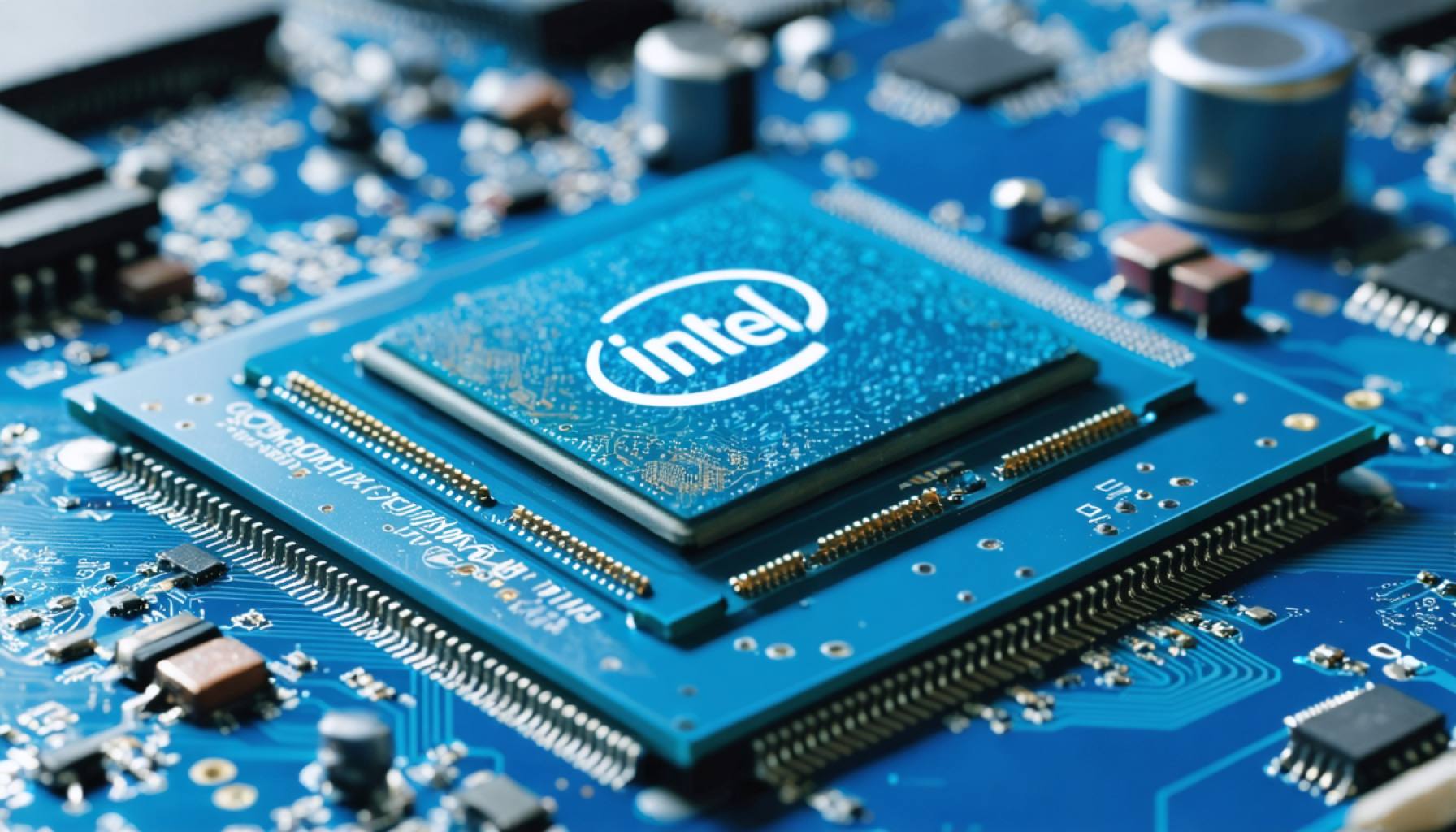
- Intel’s stock dropped over 10% during a volatile day in financial markets, alongside major indices like the S&P 500 and Nasdaq Composite.
- A potential alliance with Taiwan Semiconductor Manufacturing Company (TSMC) could rejuvenate Intel’s struggling foundry operations.
- TSMC’s potential 20% stake in a new Intel entity marks a strategic collaboration aimed at boosting operational speed and innovation.
- Despite the promising partnership, U.S.-China trade tensions loom, with China imposing a 34% tariff on American goods, threatening Intel’s market position in China.
- The situation underscores the need for adaptation and resilience amidst global trade uncertainties.
A day of stark fluctuations in the financial markets saw Intel’s fortunes plummet starkly, despite a flicker of hope on the horizon. The iconic chipmaker, synonymous with innovation yet beleaguered by a slow-moving behemoth’s woes, witnessed its stock tumble by over 10% amidst widespread market tremors. As the S&P 500 and Nasdaq Composite turned a deep crimson, all eyes turned not just towards Wall Street’s screens, but towards an unfolding drama halfway across the world.
Challenging Dynamics as Giants Converge
Intel’s lifeline could materialize in the form of a groundbreaking agreement with Taiwan Semiconductor Manufacturing Company (TSMC). Known for their prowess in chip manufacturing, TSMC stands at the pinnacle of technological finesse. A strategic collaboration between Intel and this global titan could herald a rejuvenation for Intel’s flagging foundry operations. This transformative partnership promises a fusion of expertise and potential cultural metamorphosis—necessary operational speed and innovation injected into Intel’s core.
In this visionary alliance, TSMC would command a 20% stake in a newly minted entity overseeing Intel’s semiconductor facilities. This blend of resources and knowledge, between erstwhile competitors, signals a bold step towards tackling Intel’s internal challenges.
Trade Turbulence Overshadows Progress
Yet, the optimism surrounding this deal was abruptly overshadowed by tumultuous trade winds. The global landscape turned hostile as China retaliated against U.S. tariffs with a hefty 34% levy on American goods, triggering fresh waves of uncertainty. Intel, with substantial stakes in the Chinese market, now faces arduous challenges. The tariffs threaten to erode its competitive edge, risking a dangerous ceding of market share to domestic Chinese players poised to capitalize on this geopolitical rift.
For investors and analysts, Intel remains an intriguing entity; a titan wrestling with ever-evolving obstacles. Its potential transformation is tantalizing, but the current climate injects caution into the narrative. Until clarity is restored to the turbulent trade seas, venturing boldly appears prudent rather than indulging the whims of an unpredictable market.
As Intel contemplates its course amid a storm of change, this moment outlines a modern parable of adaptation and resilience. The digital age’s pioneers must consistently evolve, riding the rhythm of global commerce and diplomacy, or risk obsolescence.
Intel’s Strategic Moves: Can a Partnership with TSMC Revitalize the Chip Giant?
Exploring Intel’s Current Predicament and Path Forward
Intel’s recent 10% stock drop amid financial market instability marks a critical juncture for the semiconductor leader. Although the decline is alarming, a potential partnership with Taiwan Semiconductor Manufacturing Company (TSMC) could revitalize Intel’s fortunes. Here’s a detailed look at the situation, future trends, and actionable insights for stakeholders.
Key Factors Affecting Intel
1. Partnership Dynamics: Intel’s proposed collaboration with TSMC could bring essential innovation and agility to its operations. TSMC’s 20% proposed stake represents a deeper integration of their advanced manufacturing capabilities with Intel’s storied technological foundation.
2. Trade Tensions: The U.S.-China trade conflict poses a significant threat, with China’s retaliatory tariffs affecting Intel’s profitability and market position, particularly given its dependencies on the Chinese market.
3. Market Volatility: Fluctuations in the S&P 500 and Nasdaq Composite signify broader economic uncertainties that could impact Intel’s stock performance in the near term.
How-To Steps for Stakeholders
For Investors:
– Diversify Portfolios: Given the volatility, maintaining diversified investment portfolios can mitigate risks associated with Intel-specific challenges.
– Monitor Trade Developments: Keep an eye on trade negotiations, as any positive breakthroughs could stabilize Intel’s market standing.
For Intel Executives:
– Strengthen Alliances: Expedite agreements with TSMC to leverage their chip manufacturing prowess more effectively.
– Expand Alternatives: Reduce reliance on China by exploring partnerships and market entries in other regions.
Real-World Use Cases
The Intel-TSMC partnership could lead to faster production cycles, improved chip designs, and better competitiveness against key rivals like AMD and NVIDIA. This would position Intel favorably in booming tech sectors such as artificial intelligence, autonomous vehicles, and IoT.
Market Forecasts & Industry Trends
– Continued Demand for Semiconductors: Despite current issues, global demand for semiconductors is expected to grow, driven by technology advancements and increased digitalization.
– Geopolitical Impact: Ongoing U.S.-China relations will play a critical role in shaping the industry landscape. Any easing of tensions would likely benefit Intel significantly.
Controversies & Limitations
– Cultural Challenges: Integrating TSMC’s operational practices with Intel’s established culture may present challenges. Successful collaboration requires overcoming potential cultural and strategic misalignments.
– R&D Investment: Intel needs to balance its budget between R&D and infrastructure to ensure long-term technological leadership.
Security & Sustainability
Implementing sustainable production processes and ensuring the security of supply chains will be pivotal. Intel and TSMC must prioritize eco-friendly practices and robust cybersecurity measures to maintain trust and resilience.
Insights & Predictions
– Short-term Volatility: Expect continued volatility as trade barriers and financial market uncertainties persist.
– Long-term Opportunities: Successful integration with TSMC and strategic pivots could see Intel regaining leader status in the semiconductor industry.
Conclusion and Recommendations
For investors and market observers, remain patient yet vigilant — Intel’s transition period may be rocky, but it also holds potential for remarkable gains if managed adeptly. For those considering investments:
– Stay Informed: Regularly review industry reports and expert analyses to stay ahead of market movements.
– Consider Long-term Value: Focus on the long-term potential of Intel’s strategic maneuvers over short-term stock motions.
For more insights on tech innovations and market strategies, visit the Intel website.



